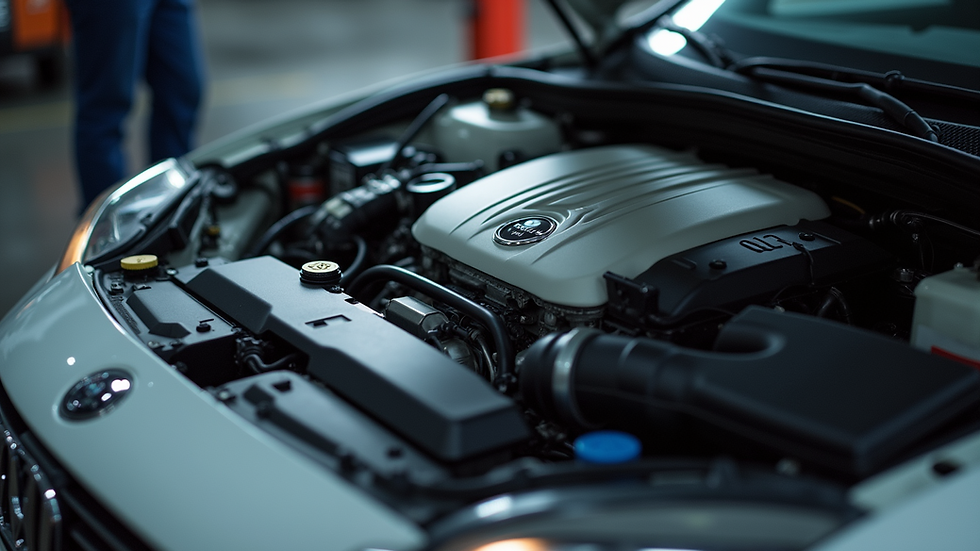The Ultimate Guide to Used Car Inspections in Abu Dhabi
- sreenath e.p
- Aug 21
- 4 min read
Updated: Nov 7
Understanding the Importance of a Used Car Inspection in Abu Dhabi
A used car inspection is crucial when buying. It provides insights into key aspects of the vehicle, including its condition, history, and potential future issues. For example, in Abu Dhabi's hot climate, regular overheating can occur, leading to engine problems. By conducting an inspection, buyers can uncover hidden issues, such as transmission failures or signs of previous accidents.
Statistics show that purchasing a car with undisclosed issues can lead to costs over AED 5,000 for repairs within the first year. By being proactive with an inspection, buyers can negotiate better prices or avoid costly repairs entirely.
Step 1: Gather Necessary Documentation
Before starting the physical inspection, gather all necessary paperwork related to the vehicle. This includes:
Car registration documents
Service history records
Previous inspection reports
Warranties or guarantees
This documentation offers a clearer picture of the vehicle's maintenance history. For example, a well-documented service history with regular oil changes may indicate that the car has been cared for properly.
Step 2: Conduct a Visual Inspection
Beginning with a thorough visual inspection is essential. Look for signs of damage, rust, or wear. Pay attention to:
Exterior: Check for dents, scratches, and paint inconsistencies. Rust often hides around wheel wells and the undercarriage, especially in humid areas.
Interior: Inspect upholstery, the dashboard, and controls. Ensure features such as the air conditioning and audio systems work properly. A non-functional air conditioning system in Abu Dhabi's heat could signal a high repair cost.
Tires: Examine the tires for uneven wear, which may indicate alignment problems. Proper tread depth is vital for safe driving; a depth below 3 mm poses safety risks.

Step 3: Check Under the Hood
The engine is vital, making a thorough under-hood inspection critical. Look for:
Fluid Levels: Check oil, coolant, and brake fluid levels. Low levels can indicate neglect. Regular oil changes every 5,000 km are essential for longevity.
Belts and Hoses: Look for wear, cracks, or fraying. Replacing a timing belt can cost anywhere from AED 1,500 to AED 3,000, so assessing their condition early saves money.
Battery: Check for corrosion around battery terminals and ensure it is securely mounted. A weak battery can leave you stranded, especially in the challenging climate.
Step 4: Take the Car for a Test Drive
A test drive is a crucial step in the inspection. It allows you to assess performance and handling. During the drive, focus on:
Engine Performance: Listen for unusual noises such as knocking or grinding. The engine should start smoothly without hesitation.
Braking: Test brakes at various speeds. They should respond promptly without grinding or pulling to one side. Ensure the braking distance feels normal; long distances indicate potential issues.
Steering and Suspension: Ensure the steering is responsive; any vibrations could indicate alignment problems.
Step 5: Utilize Diagnostic Tools
For a more thorough inspection, consider using diagnostic tools. An OBD-II scanner can reveal errors in the car’s electronic systems. For instance, it can help detect issues like faulty sensors or emissions problems.
If you're unfamiliar with these tools, hiring a professional mechanic can uncover hidden problems, ensuring nothing is overlooked.
Step 6: Review the Vehicle History Report
A vehicle history report is vital as it summarizes the car's past. It typically includes:
Previous accidents
Title status (e.g., salvage or rebuilt)
Service history
Mileage discrepancies
For example, a vehicle with a history of multiple accidents may not be a good purchase, even if it appears pristine on the outside.
Step 7: Negotiate Based on Findings
After the inspection, use gathered information to negotiate the price. If issues are identified, discuss them with the seller. For instance, if the air conditioning requires repair, you could negotiate a price reduction of AED 1,000 or propose that the repair be completed before the sale.
Approach negotiations professionally. A well-informed buyer is more successful at securing a fair deal.
Step 8: Finalize the Purchase
Once an agreement is reached, ensure all paperwork is completed accurately. This includes:
Transferring the title
Completing the registration process
Documenting warranties or guarantees
Double-check all documents to avoid future complications. Correctly managing paperwork can prevent headaches later, ensuring a smooth transition of ownership.

Additional Tips for a Successful Purchase
Research the Market
Before you start your inspection, do some research on the make and model you’re interested in. Knowing the average price range can help you spot a good deal.
Be Prepared to Walk Away
If something doesn’t feel right during the inspection or the test drive, don’t hesitate to walk away. There are plenty of options available, and it’s better to wait for the right one.
Trust Your Instincts
Sometimes, your gut feeling can be a great guide. If you feel uneasy about a particular vehicle or seller, it’s okay to look elsewhere.
Final Thoughts
Completing a thorough used car inspection in Abu Dhabi is vital for both buyers and sellers. Following these key steps ensures informed decisions and can help avoid pitfalls. Whether you’re buying or selling, recognizing the importance of a well-documented inspection process leads to smoother transactions and greater peace of mind.
Investing time in your inspection can save money and future headaches. Remember, a well-informed buyer is a successful buyer. Happy car hunting!




Comments